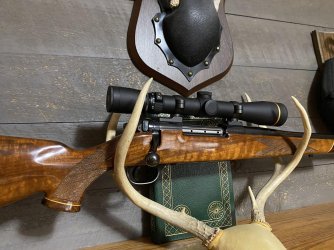pavementends
Well-Known Member
- Joined
- Nov 30, 2017
- Messages
- 61
I want to set up one of the family heirloom rifles as a proper, ready to go hunting rifle that will be accurate and reliable. If there is a lot of misaligned tension in the scope mount, I'll worry the scope base screws will break again.
Some fine people have suggested various ambitious courses of action involving lathes and jigs. Others have proposed that I ignore the misalignent and just screw the pieces together.
How about this for a middle of the road fudd home gunsmith solution:
First a separate, straight, piece of picatinny rail to mount decent rings to a seemingly straight scope. I then decide which of my loose scope bases appears to be taller than the other (with respect to the top surface on which the scope mount stands). Could possibly create a difference in height with a thin shimming operation, but holding the rifle to flat surfaces make it seem as if the front base is true and the rear is unaligned and lower than the front.
The base which appears taller and truer is left screwed in place while I put a smudge of some bedding compount beneath the other. I then use the scope with the prepared scope rings to force the floating base in alignment with the screwed fixed base.
Once you have decided to us a pic rail you are half way there. Most rails are quite "true" you should be able to mount the rail shimming which ever end needs it, and use epoxy to insure there is no stress on the rail. Then with the use of Burris rings with the inserts you should be able to align the scope also without stress. Nothing should bend when you tighten things up and the Burris rings are great.I want to set up one of the family heirloom rifles as a proper, ready to go hunting rifle that will be accurate and reliable. If there is a lot of misaligned tension in the scope mount, I'll worry the scope base screws will break again.
Some fine people have suggested various ambitious courses of action involving lathes and jigs. Others have proposed that I ignore the misalignent and just screw the pieces together.
How about this for a middle of the road fudd home gunsmith solution:
First a separate, straight, piece of picatinny rail to mount decent rings to a seemingly straight scope. I then decide which of my loose scope bases appears to be taller than the other (with respect to the top surface on which the scope mount stands). Could possibly create a difference in height with a thin shimming operation, but holding the rifle to flat surfaces make it seem as if the front base is true and the rear is unaligned and lower than the front.
The base which appears taller and truer is left screwed in place while I put a smudge of some bedding compount beneath the other. I then use the scope with the prepared scope rings to force the floating base in alignment with the screwed fixed base.


